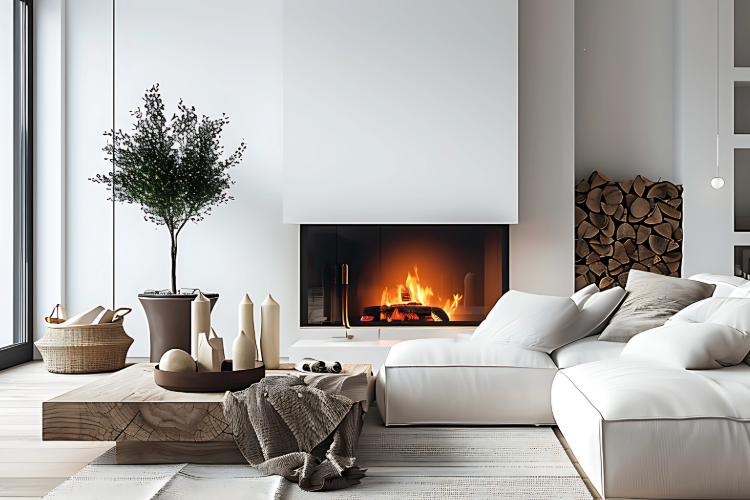
The organic modern home décor style has become one of the most sought-after interior design trends in 2024. It’s a design approach that blends the clean lines and simplicity of modern design with natural, earthy elements. The result is a space that feels warm, inviting, and connected to nature. It’s a perfect style for anyone looking to create a home that’s both sophisticated and serene.
Organic Modern Home Décor: inspiration and origins
Reflecting a broader cultural shift towards sustainability, wellness, and a more harmonious relationship with the natural world, organic modern home décor has strong links with the organic architecture movement.
In the early 20th century, a seminal architect named Frank Lloyd Wright developed the concept of ‘organic architecture.’[1] His ideas significantly shaped those of the organic modern home décor trend.
Wright sought to create harmony between the buildings we construct and live in and the natural environment. He believed in flow and that items held a purpose that was not purely aesthetic. In a famous quote Frank Llyod Wright said:
“Form follows function – that has been misunderstood. Form and function should be one, joined in a spiritual union.”[2]
This idea formed part of the open plan spaces he was famous for creating, and the way in which he harmonised indoor and outdoor to coexist together in the design of his buildings. He believed that purpose and beauty should be one.
Wright was not the sole designer inspiring the organic modern décor movement. There were other key influences that played a part in its creation, to shape the trend as we know it today.

Other key Influences inspiring organic modern home decor
The Scandinavian design movement of the mid-20th century also played a crucial role in shaping Organic Modern aesthetics. Key designers who influenced this trend include:
- Alvar Aalto: A Finnish architect and designer known for his organic forms and use of natural materials.
- Hans Wegner: A Danish furniture designer whose clean-lined yet organic chairs epitomize the blend of modern and natural.
- Arne Jacobsen: A Danish architect and designer whose streamlined furniture designs often incorporated organic shapes.
- Biomorphism in Art: The biomorphic forms found in the works of artists like Jean Arp and Joan Miró have also influenced the curved, organic shapes prevalent in Organic Modern décor.
- Wabi-Sabi Philosophy: While not an art movement per se, the Japanese aesthetic philosophy of wabi-sabi has significantly influenced the Organic Modern trend. This is particularly evident in the style’s appreciation of natural imperfections and simple, uncluttered spaces.
- Several contemporary designers also helped to shape and popularize the Organic Modern trend:
- Axel Vervoordt: A Belgian designer known for his minimalist yet warm interiors that blend antiques with modern pieces.
- Kelly Wearstler: An American designer whose bold, organic-inspired forms have become iconic in modern interior design.
- Nate Berkus: His approach to incorporating natural elements and textures into modern spaces has been influential in popularizing the Organic Modern look.
The Organic Modern trend represents a confluence of various design movements and philosophies, blending historical influences with contemporary sensibilities to create a style that feels both timeless and of-the-moment. This of the moment design translates to help people who embrace it in their home décor feel in the moment as they experience their day to day routine at home.
It is from the above principles of these designers and philosophies that we can see the formation of the principles of modern organic home décor. The Organic Modern style emerged as a response to the stark minimalism and industrial designs that dominated in the early 2000s. It began gaining popularity in the mid-2010s and has since become a major trend in home décor.

How to Achieve the Organic Modern Look in your home
Organic modern décor is about more than just aesthetics; it focuses on using sustainable materials, earthy color palettes, and organic shapes to create a home that feels grounded and balanced. The key to achieving the look for your home involves embracing the following key style principles:
- Balance natural and modern elements
- Use a neutral color palette
- Incorporate sustainable materials
- Create open, uncluttered spaces
Balance natural and modern elements
Natural materials are at the heart of this style. Wood, particularly in light or natural finishes, is a staple in organic modern décor. Think of oak or walnut furniture, reclaimed wood accents, or wooden beams that bring warmth to a modern space. Celebrate the imperfection in the wood as part of the design.
Stone is another essential material in this design approach. Whether used in countertops, floors, or decorative elements like planters or sculptures, stone adds an earthy, grounding effect. Marble, travertine, and slate are popular choices for adding a luxurious yet natural feel to spaces. Think about the texture of stone when incorporating this into your design. It can have cold, hard industrial vibes.
Organic modern homes also embrace the use of sustainable textiles such as cotton, linen, and wool. These materials not only add texture and comfort but also contribute to the eco-friendly ethos of this style. Upholstery, curtains, and rugs made from natural fibres fit perfectly into this design scheme and help soften the harder, more minimalist lines of modern furniture in your home décor.
Use a neutral color palette
The color palette for organic modern home décor is inspired by nature. Soft neutrals such as beige, cream, taupe, and warm grey are often used as the base colors. These tones create a calm and soothing environment, making it easy to layer in other elements like texture, pattern, and material.
While the primary colors are neutral, organic modern design allows for the inclusion of earth tones like muted greens, clay, terracotta, and soft browns. These colors can be brought in through accessories, artwork, or furniture to add depth and warmth to the space. They are subtle enough to blend with the minimalist modern aesthetic but rich enough to bring a sense of nature indoors.
To keep the space feeling modern, it’s important to avoid overly bright or bold colors. Instead, stick to soft, natural hues that complement the overall neutral backdrop. These colors will help create a sense of harmony and tranquility in your home.
Sustainability Materials
One of the defining characteristics of organic modern home décor is its focus on sustainability. As we become more aware of the environmental impact of our choices, this style has evolved to include eco-friendly practices.
Choosing furniture and décor made from sustainable materials is a key part of this approach. Look for furniture made from FSC-certified wood, which ensures that the wood comes from responsibly managed forests. Reclaimed wood is another excellent choice, adding both character and sustainability to your space.
Eco-friendly décor also extends to the textiles you choose. Opt for organic cotton, wool, or linen, which are grown and processed without harmful chemicals. These textiles are not only better for the environment but also more comfortable and durable.

Bring Nature Indoors
Incorporating natural elements like houseplants, dried flowers, and natural textures is a big part of organic modern home décor. Adding greenery to your living spaces instantly livens up the room creating a connection with the outdoors, encouraging peace and calm in your room. Plants such as fiddle-leaf figs, snake plants, and pothos are popular choices due to their low-maintenance nature and sculptural look.
Using natural décor elements like wooden bowls, ceramic vases, and woven baskets is another way to bring an organic touch to your space. These items add texture and dimension to a modern interior without overpowering it. The idea is to keep the décor understated but impactful, allowing the beauty of nature to shine through.
Incorporating organic shapes is also key. Instead of sharp, geometric lines, organic modern design favors curved, flowing forms that mimic those found in nature. Whether it’s an arched doorway, a circular coffee table, or a rounded armchair, these shapes bring a sense of softness to the sleek lines typical of modern décor.
Create open, uncluttered spaces
Although modern design is known for its minimalist approach, organic modern décor focuses on making minimalism feel comfortable and welcoming. Rather than stark and sterile, this style emphasizes warmth and coziness.
A minimalist aesthetic doesn’t mean sacrificing comfort. Organic modern interiors prioritize functional furniture that also offers comfort. Think plush, upholstered sofas in soft fabrics like linen or cotton, paired with cozy throw blankets and pillows. The key is to keep the design uncluttered while ensuring that every piece in the room serves a purpose and contributes to the overall sense of comfort.
Decluttering is essential in maintaining the clean lines and simplicity that are hallmarks of modern design. However, organic modern décor doesn’t strive for the austerity often associated with minimalism. Instead, it encourages a balance between simplicity and liveability. Rooms are styled to allow for flow and a sense of openness.
Organic Modern in Different Spaces
The Organic Modern trend represents a desire to reconnect with nature while maintaining a contemporary aesthetic. If your lifestyle aims for sustainability, wellness, and a more harmonious relationship with the natural world this trend is perfect for you.
You can incorporate into different spaces in your home or throughout, the choice is yours. Each space can be transformed into a peaceful, natural retreat with the right combination of materials, colors, and textures.
In the living room, focus on creating a cozy yet uncluttered space. Incorporate natural materials like wood and stone into your furniture and décor, and use soft, neutral textiles for added comfort. Keep the space minimal but functional, with plenty of natural light to enhance the organic feel.
For the bedroom the organic modern style is perfect, promoting tranquillity and relaxation. Choose natural linens for your bedding, incorporate wood accents in your furniture, and keep the décor simple. A few potted plants can add life and vibrancy to the space without overwhelming the minimalist design.
In the kitchen, natural stone countertops, wooden cabinets, and minimalist shelves are perfect for achieving an organic modern look. Keep the space open and bright, with natural materials taking center stage. Stainless steel appliances you may associate with a more industrial look can add a sleek, modern touch without detracting from the organic feel.
The bathroom is another ideal space to incorporate organic modern décor. Think natural stone sinks, wooden vanities, and eco-friendly textiles like cotton towels. Add a few spa-like elements, such as candles or essential oils, to enhance the calm, serene atmosphere that organic modern design fosters.
Conclusion
The organic modern home décor style is the perfect blend of sleek modern design and natural, earthy elements. It’s a versatile approach that works in any space and offers a balanced, serene atmosphere that promotes both style and sustainability.
By incorporating natural materials, neutral color palettes, and sustainable choices, you can create a home that feels both contemporary and connected to nature. This trend is not only visually appealing but creates a comfortable serene home you’ll love.
[1] The 20th-Century Architecture of Frank Lloyd Wright – UNESCO World Heritage Centre
[2] Form Follows Function | The Guggenheim Museums and Foundation








